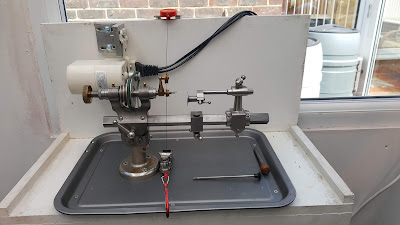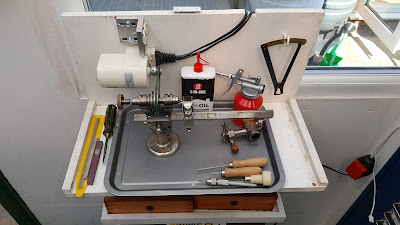1927 "Services Warch Co" ARMY `FOREIGN` Pocketwatch
(movement made by Thiel Brothers Thuringia, Germany.
Services Army Pocket Watch – Pre War with a PIN LEVER movement.
Full photograph album Click here
The Services Watch Co., Ltd was founded in Leicester by a Frank Liquorish sometime in 1926/27, it was dissolved on 26/11/2002 although I gather from Steve Burrage who used to work for the company that Services watches stopped being produced in the late 1970s. The company never actually made watches themselves instead they either had them made by other firms or bought parts in which were then assembled in the Services factory.
Pin-lever or pin-pallet escapement is an inexpensive, less accurate version of the lever escapement, used in mechanical alarm clocks, kitchen timers, mantel clocks and, until the 1970s, cheap watches now known as pin lever watches. It was patented by German watchmaker Georges Frederic Roskopf in 1867, suggested to Roskopf by Jules Grossmann.
An escapement is a mechanism in a mechanical timepiece that gives the balance wheel pushes to keep it moving back and forth and releases the timepiece's gears to advance a fixed amount with each swing of the wheel, thus moving the hands forward at a steady rate. The pin pallet escapement is similar to the lever escapement, which is used in quality watches, except that the horizontal jewel pallets on the lever are replaced with vertical metal pins, and the shape of the escape wheel teeth is modified.
The pin pallet escapement was widely used as it had many of the advantages of the lever escapement but was easier to manufacture. The pallets in a traditional lever escapement have two angled faces, the locking face and the impulse face, which engage the escape wheel teeth. They must be adjusted to precisely correct angles for the escapement to function. In the pin pallet escapement, these faces are designed into the shape of the escape wheel teeth instead, eliminating the need for costly adjustments. However, the metal pins used instead of pallets have much higher friction than jewelled pallets and combined with the looser manufacturing tolerances this made pin pallet timepieces less accurate. The metal pins also wear more quickly. Pin pallet timepieces are usually too cheap to justify repairing and are usually thrown away when they break down or wear out.
Once I had removed the dial and hands and the simple winding and setting mechanism, time to remove the movement from the case, which more difficult than expected. It took my large case back opener to turn the movement in the case until it popped out.
Replaced the discoloured acrylic crystal with a new 44mm glass crystal.
Albert Chain with watch
Marking on-chain are Anchor ( Birmingham), Lion (Sterling Silver) and B (1926)
Sterling Silver mark on all rings in the chain.
Date marking on the Shield is 28-2-27.
(movement made by Thiel Brothers Thuringia, Germany.
Services Army Pocket Watch – Pre War with a PIN LEVER movement.
Full photograph album Click here
The Services Watch Co., Ltd was founded in Leicester by a Frank Liquorish sometime in 1926/27, it was dissolved on 26/11/2002 although I gather from Steve Burrage who used to work for the company that Services watches stopped being produced in the late 1970s. The company never actually made watches themselves instead they either had them made by other firms or bought parts in which were then assembled in the Services factory.
Pin-lever or pin-pallet escapement is an inexpensive, less accurate version of the lever escapement, used in mechanical alarm clocks, kitchen timers, mantel clocks and, until the 1970s, cheap watches now known as pin lever watches. It was patented by German watchmaker Georges Frederic Roskopf in 1867, suggested to Roskopf by Jules Grossmann.
An escapement is a mechanism in a mechanical timepiece that gives the balance wheel pushes to keep it moving back and forth and releases the timepiece's gears to advance a fixed amount with each swing of the wheel, thus moving the hands forward at a steady rate. The pin pallet escapement is similar to the lever escapement, which is used in quality watches, except that the horizontal jewel pallets on the lever are replaced with vertical metal pins, and the shape of the escape wheel teeth is modified.
The pin pallet escapement was widely used as it had many of the advantages of the lever escapement but was easier to manufacture. The pallets in a traditional lever escapement have two angled faces, the locking face and the impulse face, which engage the escape wheel teeth. They must be adjusted to precisely correct angles for the escapement to function. In the pin pallet escapement, these faces are designed into the shape of the escape wheel teeth instead, eliminating the need for costly adjustments. However, the metal pins used instead of pallets have much higher friction than jewelled pallets and combined with the looser manufacturing tolerances this made pin pallet timepieces less accurate. The metal pins also wear more quickly. Pin pallet timepieces are usually too cheap to justify repairing and are usually thrown away when they break down or wear out.
Once I had removed the dial and hands and the simple winding and setting mechanism, time to remove the movement from the case, which more difficult than expected. It took my large case back opener to turn the movement in the case until it popped out.
I put the movement aside and first set to refit the loose tube to the case.
Now onto the Pin Lever movement, which is the first one I have seen and worked on, so took plenty of photographs before disassembling it!
First, it was noticing the Balance cock has the pivot to the pin lever as well as the balance pivot. This was not a Jewel but a screw with a steel cone for the "Jewel"!
So I remove the balance cock and then the pin lever.
Next, remove the full-bridge plate.
Next to disassemble the train wheels, due to the cannon pinion being fixed to the centre wheel pivot!
Due to this movement not being like other movements and does not turn on shaft.
So start with the escape wheel, third, second, etc.
Next to clean all the parts.
Reassembled the movement.
Movement ticking well
Time refit the cleaned dial and hands and complete the assemble.
Cleaned up the Albert chain which is hallmarked: Anchor (Birmingham) Lion (Sterling Silver) and B (1926). There is also a date stamped on the reverse of the shield 28-2-27
Albert Chain with watch
Marking on-chain are Anchor ( Birmingham), Lion (Sterling Silver) and B (1926)
Sterling Silver mark on all rings in the chain.
Date marking on the Shield is 28-2-27.

























